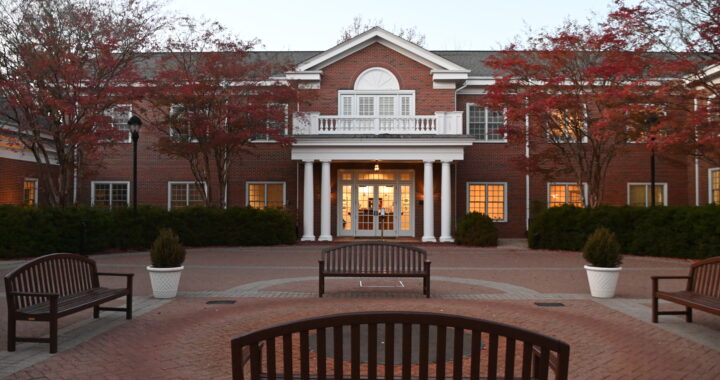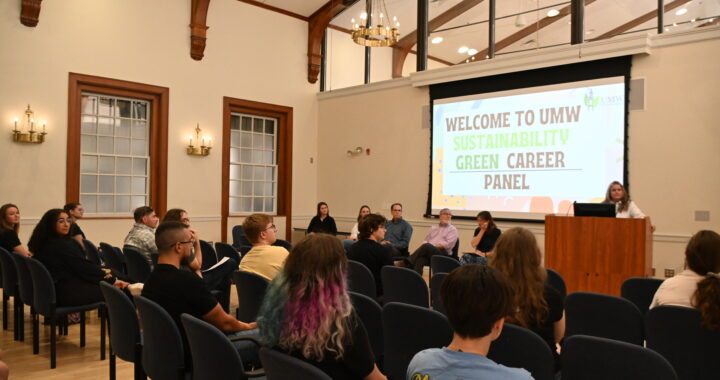Monroe Hall: behind the scenes
4 min readWarning: Attempt to read property "post_excerpt" on null in /home/bgonline/public_html/wp-content/themes/newsphere-pro/inc/hooks/hook-single-header.php on line 65
By ISAAC WHALEN
“DANGER CONSTRUCTION AREA AUTHORIZED ENTRY ONLY,” warned the red and white sign on the wire fence outside Monroe Hall.
Monroe Hall is one of the last three original buildings on campus. In 1911, when it first opened, Monroe housed a swimming pool, administrative offices and a gymnasium. Now, 100 years later, it sits behind an exoskeleton of metal scaffolding and plywood.
The building is getting a “facelift” with new bricks, mortar, windows and columns along with a new “circulatory system” of air conditioning, heating and better ventilation.
Due to the building’s age, ordinary renovations are complicated—much of the original construction used lead paint. Thus, the university needed to contract a company with a history of dealing with hazardous materials, and Sigal Construction Company answered the call.
Sigal won the competitive bid to renovate Monroe Hall in 2009, beating out roughly 15 other companies with similar experience with historic renovations.
According to the company’s website, Sigal is one of the “oldest locally owned and operated builders in the Washington Metropolitan Region” and has renovated numerous historic D.C. buildings, including the U.S. Army Corps of Engineers Headquarters and the Department of State’s Harry S. Truman Building.
Mary Washington is not the only historic campus in Virginia to renovate its memorable buildings. In 2005, James Madison University spent $9.7 million to renovate its 90-year-old Harrison Hall for the first time in 30 years. On February 5, 2010, The Daily Progress reported that the University of Virginia was lobbying for $50.6 million in total renovation funding, $4.59 million of which would go to repairing the Rotunda’s leaking metal roof with a copper one.
At UMW, the renovations seem to be almost constant. Whether it was the graffiti- smattered wood partition of Lee Hall in 2008 or the man-made hills of dirt for Eagle Village in 2009, UMW always seems to be under construction.
The Board of Visitors is not blind to this situation and has been trying to address this problem. In the July 16 meeting, the B.O.V. stated that there needs to be a focus placed on the “sequencing of implementation” to ensure the campus “never looks like a construction zone.” Len Shelton, associate director of capital planning and construction with the university’s facility services, commented on the difficulty of this task. Other than keeping all of the work within the fence there is not much else one can do “when you’re working on the outside of a building.”
Construction usually runs daily from 7 a.m. to 3 p.m. with a few hours set aside as “quite time,” according the site’s project manager, Bruce Blair.
With a projected completion date of August 2012, it is not the appearance of construction that bothers some. Rather there has been a greater outcry at the prospect of these renovations hurting the historic nature of the buildings themselves.
As reported by the Bullet, many members of the school’s historic preservation department have been concerned about possible damage to Monroe’s murals.
Blair was aware of these worries before beginning the renovations and assured that the murals will not be harmed.
“They’re covered right now with plywood and we are working around them,” he said.
On every wall large portions were sectioned off with plywood and bordered with layers of blue painters tape. All of the murals were also photographed and documented, according to Blair.
According to Shelton, the historic preservation department that has been involved with the renovations “since day one.”
On the second floor, there is a weathered looking door with a piece of the same blue tape on its front with the word “SAVE” written in Sharpie. According to Blair, notes such as those are being used so those involved with the renovations know what is being preserved.”
Other than the first floor murals almost every door, door frame and wall molding were original.
According to Blair, things are pretty much on track despite some set backs early on in the project. The iconic columns on the façade of Monroe, for example, were to be easily replaced with new fiberglass-reinforced-plastic models until it was discovered these were actual structural support columns, a fact missing in the building’s blue prints.
After the replacement process began on the columns, it was discovered that they secretly housed a massive honeybee colony. This required specialized ecological preservation measures, an incident Blair was directly involved with. High-winds that week also presented difficulty to the workers as it impeded roof repairs and remodeling.
Despite these setbacks, Blair and the rest of the Sigal Construction Company have been working non-stop to ensure that the Monroe Hall renovations continue according to plan. Although there are complaints regarding how long the construction has been taking, change is coming.


